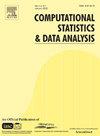Inference for the stochastic FitzHugh-Nagumo model from real action potential data via approximate Bayesian computation
IF 1.5
3区 数学
Q3 COMPUTER SCIENCE, INTERDISCIPLINARY APPLICATIONS
引用次数: 0
Abstract
The stochastic FitzHugh-Nagumo (FHN) model is a two-dimensional nonlinear stochastic differential equation with additive degenerate noise, whose first component, the only one observed, describes the membrane voltage evolution of a single neuron. Due to its low-dimensionality, its analytical and numerical tractability and its neuronal interpretation, it has been used as a case study to test the performance of different statistical methods in estimating the underlying model parameters. Existing methods, however, often require complete observations, non-degeneracy of the noise or a complex architecture (e.g., to estimate the transition density of the process, ‘‘recovering’’ the unobserved second component) and they may not (satisfactorily) estimate all model parameters simultaneously. Moreover, these studies lack real data applications for the stochastic FHN model. The proposed method tackles all challenges (non-globally Lipschitz drift, non-explicit solution, lack of available transition density, degeneracy of the noise and partial observations). It is an intuitive and easy-to-implement sequential Monte Carlo approximate Bayesian computation algorithm, which relies on a recent computationally efficient and structure-preserving numerical splitting scheme for synthetic data generation and on summary statistics exploiting the structural properties of the process. All model parameters are successfully estimated from simulated data and, more remarkably, real action potential data of rats. The presented novel real-data fit may broaden the scope and credibility of this classic and widely used neuronal model.
通过近似贝叶斯计算从真实动作电位数据推断随机菲茨休-纳古莫模型
随机菲茨休-纳古莫(FHN)模型是一个带有加性退化噪声的二维非线性随机微分方程,其第一个分量(唯一观测到的分量)描述了单个神经元的膜电压演变。由于该模型的低维度、分析和数值上的可操作性以及对神经元的解释,该模型已被用作案例研究,以测试不同统计方法在估计基本模型参数方面的性能。然而,现有的方法往往需要完整的观测数据、噪声的非退化性或复杂的结构(例如,估计过程的过渡密度,"恢复 "未观测到的第二分量),而且它们可能无法(令人满意地)同时估计所有模型参数。此外,这些研究缺乏随机 FHN 模型的真实数据应用。所提出的方法可以应对所有挑战(非全局 Lipschitz 漂移、非显式解法、缺乏可用的过渡密度、噪声和部分观测值的退化)。它是一种直观且易于实现的顺序蒙特卡罗近似贝叶斯计算算法,依赖于最新的计算高效且结构保留的数值分裂方案来生成合成数据,并依赖于利用过程结构特性的汇总统计。所有模型参数都能从模拟数据中成功估算出来,更值得一提的是,大鼠的真实动作电位数据也能估算出来。这种新颖的真实数据拟合方法可拓宽这一经典和广泛应用的神经元模型的应用范围和可信度。
本文章由计算机程序翻译,如有差异,请以英文原文为准。
求助全文
约1分钟内获得全文
求助全文
来源期刊

Computational Statistics & Data Analysis
数学-计算机:跨学科应用
CiteScore
3.70
自引率
5.60%
发文量
167
审稿时长
60 days
期刊介绍:
Computational Statistics and Data Analysis (CSDA), an Official Publication of the network Computational and Methodological Statistics (CMStatistics) and of the International Association for Statistical Computing (IASC), is an international journal dedicated to the dissemination of methodological research and applications in the areas of computational statistics and data analysis. The journal consists of four refereed sections which are divided into the following subject areas:
I) Computational Statistics - Manuscripts dealing with: 1) the explicit impact of computers on statistical methodology (e.g., Bayesian computing, bioinformatics,computer graphics, computer intensive inferential methods, data exploration, data mining, expert systems, heuristics, knowledge based systems, machine learning, neural networks, numerical and optimization methods, parallel computing, statistical databases, statistical systems), and 2) the development, evaluation and validation of statistical software and algorithms. Software and algorithms can be submitted with manuscripts and will be stored together with the online article.
II) Statistical Methodology for Data Analysis - Manuscripts dealing with novel and original data analytical strategies and methodologies applied in biostatistics (design and analytic methods for clinical trials, epidemiological studies, statistical genetics, or genetic/environmental interactions), chemometrics, classification, data exploration, density estimation, design of experiments, environmetrics, education, image analysis, marketing, model free data exploration, pattern recognition, psychometrics, statistical physics, image processing, robust procedures.
[...]
III) Special Applications - [...]
IV) Annals of Statistical Data Science [...]
 求助内容:
求助内容: 应助结果提醒方式:
应助结果提醒方式:


